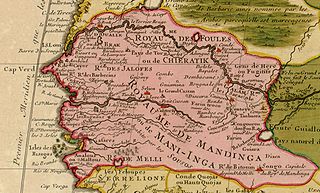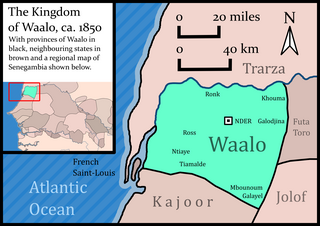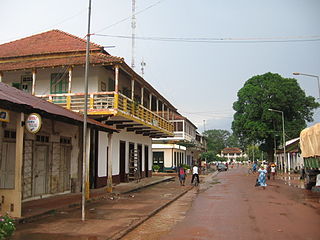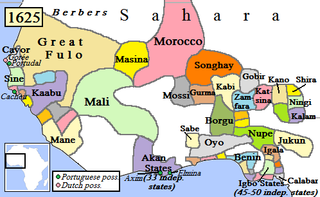Related Research Articles

The history of Senegal is commonly divided into a number of periods, encompassing the prehistoric era, the precolonial period, colonialism, and the contemporary era.

Casamance is the area of Senegal south of the Gambia, including the Casamance River. It consists of the Lower Casamance and the Upper Casamance. The largest city of Casamance is Ziguinchor.

Waalo was a kingdom on the lower Senegal River in West Africa, in what is now Senegal and Mauritania. It included parts of the valley proper and areas north and south, extending to the Atlantic Ocean. To the north were Moorish emirates; to the south was the kingdom of Cayor; to the east was Jolof.
The Senegambia is, in the narrow sense, a historical name for a geographical region in West Africa, which lies between the Senegal River in the north and the Gambia River in the south. However, there are also text sources which state that Senegambia is understood in a broader sense and equated with the term the Western region. This refers to the coastal areas between Senegal and Sierra Leone, where the inland border in the east was not further defined.

The Mandinka or Malinke are a West African ethnic group primarily found in southern Mali, the Gambia, southern Senegal and eastern Guinea. Numbering about 11 million, they are the largest subgroup of the Mandé peoples and one of the largest ethnic-linguistic groups in Africa. They speak the Manding languages in the Mande language family, which are a lingua franca in much of West Africa. Virtually all of Mandinka people are adherent to Islam, mostly based on the Maliki jurisprudence. They are predominantly subsistence farmers and live in rural villages. Their largest urban center is Bamako, the capital of Mali.

The Casamance River flows westward for the most part into the Atlantic Ocean along a path about 200 miles (320 km) in length. However, only 80 miles (130 km) are navigable. The Casamance is the principal river of the Kolda, Sédhiou, and Ziguinchor Regions in the southern portion of Senegal. It is located between the Gambia River to the north and the Cacheu and Geba rivers to the south.

Gabu is the largest town in eastern Guinea-Bissau and capital of the Gabu Region. Under the name Kansala, it was the capital of Kaabu.

The Casamance conflict is an ongoing low-level conflict that has been waged between the Government of Senegal and the Movement of Democratic Forces of Casamance (MFDC) since 1982. On May 1, 2014, the leader of the MFDC sued for peace and declared a unilateral ceasefire.

The Jola or Diola are an ethnic group found in Senegal, the Gambia, and Guinea-Bissau. Most Jola live in small villages scattered throughout Senegal, especially in the Lower Casamance region. The main dialect of the Jola language, Fogni, is one of the six national languages of Senegal.

Kaabu (1537–1867), also written Gabu, Ngabou, and N'Gabu, was a federation of Mandinka kingdoms in the Senegambia region centered within modern northeastern Guinea-Bissau, large parts of today's Gambia, and extending into Koussanar, Koumpentoum, and the Casamance in Senegal.

The Empire of Great Fulo, also known as the Denanke Kingdom or Denianke Kingdom, was a Pulaar kingdom of Senegal, which dominated the Futa Toro region from the early 16th century to 1776.
The Bainuk people are an ethnic group that today lives primarily in Senegal as well as in parts of Gambia and Guinea-Bissau.
The military history of the Mali Empire is that of the armed forces of the Mali Empire, which dominated Western Africa from the mid 13th to the late 15th century. The military culture of the empire's driving force, Mandinka people, influenced many later states in West Africa including break-away powers such as the Songhay and Jolof empires. Institutions from the Mali Empire also survived in the 19th century army of Samory Ture who saw himself as the heir to Old Mali's legacy.
The Jakhanke -- also spelled Jahanka, Jahanke, Jahanque, Jahonque, Diakkanke, Diakhanga, Diakhango, Dyakanke, Diakhanké, Diakanké, or Diakhankesare -- are a Manding-speaking ethnic group in the Senegambia region, often classified as a subgroup of the larger Soninke. The Jakhanke have historically constituted a specialized caste of professional Muslim clerics (ulema) and educators. They are centered on one larger group in Guinea, with smaller populations in the eastern region of The Gambia, Senegal, and in Mali near the Guinean border. Although generally considered a branch of the Soninke, their language is closer to Western Manding languages such as Mandinka.

Kombo was a kingdom and later a chieftaincy in Gambia during the colonial period. Kombo was part of the Mali Empire and gained independence after its fall, and was then ruled by the Sambou Bainunka clan. Mansa Karapha Yalli Jatta became the first King of Kombo, after seeking help from the then independent Kaabu Empire to establish the Kingdom of Kombo, he married the daughter of the Bainuk Queen Wullending Jasseh of Sanyang who sits at Gunjur and took her to Busumbala. Mansa Karapha Yalli Jatta was from the Jatta (Lion) clan who claim ancestry from Sundiata Keita the first Emperor of the Mali Empire. Kombo was ruled by two families, the Jatta (Djatta) and Bojang (Bodian) clans, when one clan becomes Mansa, the other clan gets to choose the crown prince from their own clan and vice versa. From 1840-1855 Mansa Suling Jatta was the King of Kombo, he was killed in the Soninke-Marabout war, and most of the Jatta clan moved to other regions.
Guelowar, also spelled Gelwar, Guelwar, Guelware, Gueleware or Gueloware, was a maternal dynasty in the pre-colonial Serer kingdoms of Sine and Saloum. They were from the Mandinka ethnic group. The offspring of Mandinka women and Serer men became the kings of Sine and Saloum. The dynasty lasted from the mid-14th century to 1969, the year both kings died.

Ziguinchor is the capital of the Ziguinchor Region, and the chief town of the Casamance area of Senegal, lying at the mouth of the Casamance River. It has a population of over 230,000. It is the seventh largest city of Senegal, but largely separated from the north of the country by The Gambia.

Wuli was a Mandinka kingdom located on the north bank of the Gambia River in what is now the eastern portion of The Gambia and the Tambacounda region of Senegal. Ruled as an independent polity by the Wali family from the early 16th century until European colonialism in the late 19th, it controlled an important crossroads for trading routes linking the upper Niger river valley with the coast.
The Tenda or Tanda are an ethnolinguistic group living in the southern Senegal, northeastern Guinea-Bissau, and northern Guinea, comprising the Bassari, the Konyagui, the Bedik, and the Badiaranke.
The Nyancho were a royal maternal dynasty that ruled the West African empire of Kaabu.
References
- ↑ Rodney, Walter (May 1966). A History of the Upper Guinea Coast, 1545-1800 (PDF) (Thesis). ProQuest.
- ↑ Mane 2021, p. 319.
- ↑ Mane 2021, p. 319-321.
- ↑ Mane 2021, p. 317.
- ↑ Minahan, James (2002). Encyclopedia of the Stateless Nations: A-C. Greenwood Publishing Group. p. 397. ISBN 978-0-313-32109-2.
- ↑ Lobban, Richard Andrew Jr.; Mendy, Peter Karibe (2013). Historical Dictionary of the Republic of Guinea-Bissau (4th ed.). Lanham: Scarecrow Press. p. 244. ISBN 978-0-8108-5310-2.
- 1 2 Mane 2021, p. 343.
- ↑ Barry, Boubacar (1992). "Senegambia from the sixteenth to the eighteenth century: evolution of the Wolof, Sereer and 'Tukuloor'". In Ogot, B. A. (ed.). General History of Africa vol. V: Africa from the Sixteenth to the Eighteenth Century. UNESCO. p. 266. Retrieved 16 September 2023.
- ↑ Brooke, George E. "Western Africa to c1860 A.D. A provisuanal historical schema based on climate periods" (PDF). University of Indiana. p. 165. Retrieved 30 May 2023.
- ↑ Mane 2021, p. 344.
- ↑ Mane 2021, p. 345.